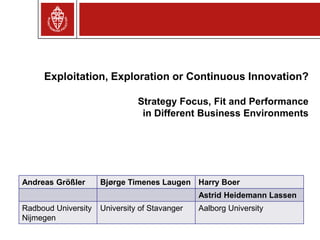Exploitation, Exploration, or Continuous Improvement
The document analyzes different competitive strategies - exploitation, exploration, and continuous innovation - and how they relate to business environment uncertainty and firm performance. It uses survey data from 677 manufacturing plants in 19 countries. Through cluster analysis, firms were grouped into low, medium, and high uncertainty environments based on factors like complexity and diversity. Firms were also classified as pursuing exploitation, exploration, or continuous innovation strategies. The analysis found that continuous innovation firms can exist across all environments. Firm performance differed based on the environment - continuous innovation firms performed best in medium and high uncertainty environments, while exploitation had no advantage in low uncertainty settings.











Recommended






















































More Related Content
Viewers also liked (12)


















Similar to Exploitation, Exploration, or Continuous Improvement (20)










































Exploitation, Exploration, or Continuous Improvement
- 1. Exploitation, Exploration or Continuous Innovation? Strategy Focus, Fit and Performance in Different Business Environments Andreas Gr├Č├¤ler Bj├Ėrge Timenes Laugen Harry Boer Astrid Heidemann Lassen Radboud University Nijmegen University of Stavanger Aalborg University
- 2. Exploitation, Exploration or Continuous Innovation? Gr├Č├¤eretal.,2010 Organisations adapt to their environment, but they also shape it. Organisation Environment Organisations as ŌĆ£co-producersŌĆØ of their environment Organisation adapts to environment 1. Instability 2. Complexity 3. Diversity 4. Hostility (Mintzberg, 1979)
- 3. Exploitation, Exploration or Continuous Innovation? Gr├Č├¤eretal.,2010 Research questions and propositions RQ1. Do firms pursuing a continuous innovation strategy exist? RQ2. To what extent does the business environment affect the choice of competitive strategy? RQ3. How successful, in terms of performance, are these strategies? P1. Most exploitative firms exist in low uncertainty business environments, while explorative firms will probably dominate high uncertainty environments . P2. Exploitation-only firms are more successful in low uncertainty business environments than explorative and continuous innovation firms. P3. Exploration-only firms are more successful in high uncertainty business environments than exploitative and continuous innovation firms.
- 4. Exploitation, Exploration or Continuous Innovation? Gr├Č├¤eretal.,2010 Data and operationalisation (i) ŌĆó International Manufacturing Strategy Survey, 5th round, 2009 ŌĆó 19 countries, 677 plants ŌĆó ISIC 28-35: machinery, tools, electrical, electronic and optical devices, measurement devices, and transportation equipment ŌĆó Director of Manufacturing, estimates and perceptions, mostly 5-point Likert scales ŌĆó Market dynamics proxy for stability (transformed), market span for complexity, geographical focus for diversity, and competition intensity for hostility
- 5. Exploitation, Exploration or Continuous Innovation? Gr├Č├¤eretal.,2010 Operationalisation (ii) ŌĆó Strategy operationalised using order winners (single-variate measurement) ŌĆō Quality ŌĆō Time exploitation ŌĆō Cost continuous innovation ŌĆō Flexibility ŌĆō Innovativeness ŌĆó (Operational) performance: three factors regarding time/cost, quality, and flexibility exploration
- 6. Exploitation, Exploration or Continuous Innovation? Gr├Č├¤eretal.,2010 Procedure and analysis 1. Split the sample (cluster analysis) based on characteristics of environment (MintzbergŌĆÖs four factors). 2. Classify the firms in the data set according to their strategy in exploitation-only, exploration-only, and continuous innovation firms based on their order-winners. 3. Using cross tabulation, investigate the representation of different firm types (exploitative, explorative and continuous innovation) in different environmental clusters. 4. Using ANOVA, investigate the relationships between different firm types and operational performance in the different environmental clusters.
- 7. Exploitation, Exploration or Continuous Innovation? Gr├Č├¤eretal.,2010 Step 1: Clustering the sample wrt. environment Three clusters appeared to be most interpretable: 1. A low uncertainty business environment: low complexity, low dynamics, low hostility and low diversity. 2. A medium uncertainty business environment: high diversity, medium hostility, medium complexity and low dynamics. 3. A high uncertainty business environment: high complexity, high dynamics, high hostility and high diversity. ’āĀ 661 firms clustered: 147 firms in the low uncertainty cluster and 257 firms in each of the two other clusters
- 8. Exploitation, Exploration or Continuous Innovation? Gr├Č├¤eretal.,2010 Step 2: Classifying firms wrt. strategy 441 firms from the sample classified: 160 firms are exploitation-only, 47 exploration-only, and 234 firms pursue a continuous innovation strategy ’āĀ RQ1: continuous innovation firms do exist!
- 9. Exploitation, Exploration or Continuous Innovation? Gr├Č├¤eretal.,2010 Step 3: Cross tabulation Strategy Cluster Exploitation -only Exploration- only Continuous innovation Total (%) Total (N) Low uncertainty 34.8% 19.4% 15.7% 29.8% 49.4% 18.8% 20.2% 89 Medium uncertainty 35.1% 37.5% 11.1% 40.4% 53.8% 39.3% 38.8% 171 High uncertainty 38.1% 43.1% 7.7% 29.8% 54.1% 41.9% 41.0% 181 Total (%) 36.3% 10.7% 53.1% 100.0 % Total (N) 160 47 234 441 ’āĀ RQ2: no link between the strategy pursued and characteristics of environment. Proposition P1 is not supported by data.
- 10. Exploitation, Exploration or Continuous Innovation? Gr├Č├¤eretal.,2010 Step 4: Strategy and performance ŌĆó Low-uncertainty business environment: ŌĆō a strategy focused on exploitation does not lead to competitive advantage over the other strategic foci ŌĆō P2 is rejected ŌĆó Medium-uncertainty business environment: ŌĆō continuous innovation firms perform significantly better than exploiters ŌĆó High-uncertainty business environment: ŌĆō firms pursuing an explorative or continuous innovation strategy perform significantly better than focused exploiters ŌĆō P3 partially supported
- 11. Exploitation, Exploration or Continuous Innovation? Gr├Č├¤eretal.,2010 Discussion and implications ŌĆó Continuous innovation firms do exist ŌĆó ŌĆ” even in a very high number: fashion, artefact, necessity, or natural development? ŌĆó No clear link between strategy and environment; in particular: why exist so many exploitation-only firms in high- uncertainty environments? ŌĆó Continuous innovation (i.e. multi-focus) firms are at least as successful as the other types; advantage of focus? ŌĆó Strategy based on order winners ŌĆō actual behaviour/ structure? ŌĆó Operational performance vs. business/financial performance





